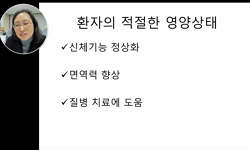Aims: Body mass index (BMI) is known to be associated with higher risk of hepatocellular carcinoma (HCC) in the general population. However, the association between BMI and risk of HCC in patients with various liver disease is not well understood. Met...
http://chineseinput.net/에서 pinyin(병음)방식으로 중국어를 변환할 수 있습니다.
변환된 중국어를 복사하여 사용하시면 됩니다.
- 中文 을 입력하시려면 zhongwen을 입력하시고 space를누르시면됩니다.
- 北京 을 입력하시려면 beijing을 입력하시고 space를 누르시면 됩니다.
Association with Body Mass Index and Risk of Hepatocellular Carcinoma According Liver Disorder Status = Association with Body Mass Index and Risk of Hepatocellular Carcinoma According Liver Disorder Status
한글로보기https://www.riss.kr/link?id=A107095364
- 저자
- 발행기관
- 학술지명
- 권호사항
-
발행연도
2020
-
작성언어
-
- 주제어
-
KDC
500
-
자료형태
학술저널
-
수록면
149-150(2쪽)
- 제공처
-
0
상세조회 -
0
다운로드
부가정보
다국어 초록 (Multilingual Abstract)
Aims: Body mass index (BMI) is known to be associated with higher risk of hepatocellular carcinoma (HCC) in the general population. However, the association between BMI and risk of HCC in patients with various liver disease is not well understood.
Methods: We used data from National Health Insurance Service (NHIS) that provides compulsory health insurance coverage and national health screening for all citizens in the Republic of Korea. Hazard ratios (HRs) were calculated using Cox regression models to examine associations between body mass index (BMI) and risk of HCC. We included 15016551 adults (aged 18-99 years) who underwent health examinations between 2003 and 2006, in the NHIS database. Participants were classified into six groups according to the liver diseases; liver cirrhosis (LC), hepatitis B or C virus infection (HBVHCV), other liver disease (O-LD), unidentified liver disease with alanine aminotransferase (ALT) ≥40 or aspartate aminotransferase (AST) ≥40 (ALT40), no known liver diseases with 20≤ALT<40 or 20≤AST<40 IU/ml (ALT2040), and ALT<20 and AST<20 (ALT20).
Results: During mean 13.7 years of follow-up. HCC occurred in 71570 individuals. In total population, BMI had a non-linear association with HCC. In BMI above 25 kg/m², BMI was positively associated with risk of HCC regardless of liver disorder. In the multivariable adjusted analysis, the HR per 5 kg/m² increase in BMI above 25 kg/m² was 1.48 (95% CI 1.44-1.52) in total population, 1.11 (95% CI 1.00-1.23) in LC, 1.12 (95% CI 1.44-1.52) in HBVHCV, 1.32 (95% CI 1.22-1.44) in O-LD, 1.07 (95% CI 1.03-1.12) in ALT40, 1.47 (95% CI 1.38-1.57) in ALT2040, 1.67 (95% CI 1.32-2.09) in ALT20. In the subgroup analysis for the HCC high-risk group, the HR of HCC (95% CI) for a 5 kg/m2 increase in BMI was 1.21 in HBV-LC (1.01-1.46), 1.13 in other LC (1.08-1.19) and 1.15 in HBV without LC (1.04- 1.27), 1.14 in HCV without LC (0.92 -1.40) and 1.05 in HCV-LC (0.64-1.74). Associations between BMI and risk of HCC in HBV (HR; 1.46 vs 1.05), HCV (HR; 1.30 vs 0.92) and LC (HR; 1.28 vs 1.02) patients were stronger in female than in male.
Conclusions: Our study showed that BMI was positively associated with risk of HCC regardless of liver disorder in BMI above 25 kg/m². As the severity of liver disease weakened, the association between increased BMI and HCC became stronger. Inpatients with HBV, HCV, and LC, the harmful effects of higher BMI on HCC risk was stronger in women than in men.
동일학술지(권/호) 다른 논문
-
Tacotsubo Cardiomyopathy Secondary to Pyogenic Liver Abscess
- 대한간학회
- ( Jeong Ill Suh )
- 2020
-
Helicobacter Pylori Prevalence in Chronic Liver Disease Patients by Using 14CUrea Breath Test
- 대한간학회
- ( Bayarjargal Altankhuyag )
- 2020
-
- 대한간학회
- ( Pil Soo Sung )
- 2020
-
- 대한간학회
- ( Soo Min Bang )
- 2020





 KISS
KISS




